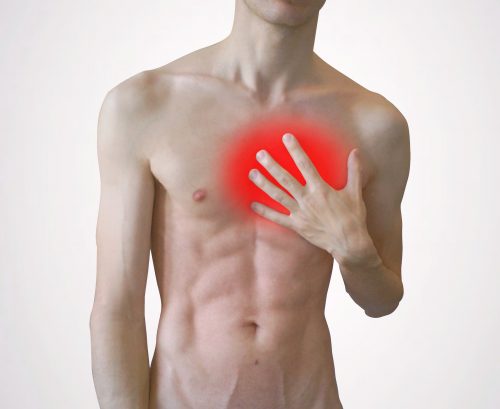A pectus carinatum is characterized by the projection of the sternum forward, thus resulting in an appearance of " sternum sticking out »
Breastbone sticking out: is it serious? The answer is difficult to specify. Indeed, for some, the deformation does not have any impact on respiratory and cardiovascular function. While for others, some malfunctions can be observed.
Nevertheless, in both cases, the prognosis of a sternum sticking out is generally good.
Discover through this article an explanation more detailed on the previous question, the factors that come into play and all the other useful information to understand the subject of pectus carinatum.
Sternum anatomy
Before going into the subject of sternum sticking out, it seems logical to first review a short anatomy lesson on the sternum :
Le sternum is the flat bone that lies in the middle of the anterior surface of the thorax. This odd bone articulates on each side with the ribs (the first seven) via the costal cartilages.
With ribs and vertebrae posteriorly, the sternum forms a structure called the rib cage. This anatomical region protects and holds the thoracic organs in place.
Pectus carinatum: Sternum sticking out (definition)
Un sternum sticking out is referred to as “Pectus Carinatum”. Also called carina or keel chest, the pectus carinatum is manifested by a forward projection of the sternum.
This protrusion of the sternum thus leads to a deformation of the anterior and middle part of the thorax, as shown in the diagram below:
Generally less common than pectus excavatum (sternum that depresses inwards), Pectus Carinatum can be symmetrical (affecting both lateral sides of the sternum) or asymmetrical (affecting the left lateral or right lateral side of the sternum)
Causes of protruding sternum
Marfan syndrome
Marfan syndrome is the most common cause an sternum sticking out. This genetic disease is systematically sought or evoked in a person with pectus carinatum.
One of the symptoms of Marfan Syndrome is excessive development cartilage of the body, including the cartilages connecting the sternum and the ribs.
Thus, costal cartilages become enlarged and will distort the position of the sternum. It will be pushed forward, hence the appearance of a sternum sticking out.
Thereby, pectus carinatum is present from birth, but it is during adolescence that the deformity becomes obvious, because of the pubertal growth spurt.
Other causes
In rarer cases, but also possible, a sternum sticking out can be associated with a Scoliosis. According to statistics, pectus carinatum would be linked to scoliosis in about 15% of cases.
Un sternum sticking out can also be seen in people with a history of heart surgery. This is therefore a secondary cause.
Symptoms and impacts
Generally, the pectus carinatum does not lead to serious consequences on the patient's health. However, some non-specific symptoms may still appear depending on the severity of the deformity. We cite for example:
- Shortness of breath on exertion leading to a feeling of fatigue or weakness.
- Atypical chest pain when the person lies on their stomach.
- Asthma-like symptoms.
- Tachycardia or a heart that beats too fast.
The severity of symptoms depends on each person. But some aggravating factors can come into play, such as:
- The practice of excessive physical activity.
- Bad positions (here, the position lying on your stomach)
Apart from these physical symptoms, the sternum sticking out leads above all to psychological and aesthetic impacts.
Psychological impacts
Un sternum sticking out does indeed have disadvantageous psychological impacts for the affected person, especially among adolescents.
The latter can develop a real complex and low self-esteem because of their deformity. They feel bad about themselves, isolate themselves from society and withdraw into themselves.
Especially since derogatory remarks from outsiders only increase their discomfort.
Aesthetic impacts
Un sternum sticking out distorts the appearance of the front of the chest. Sometimes even, when the deformation is significant, a bump appears through the layers of clothing.
Treatments
As mentioned at the very beginning of the article, the prognosis for recovery is generally Well. Many treatments can be adopted, such as:
orthopedic treatment
This treatment leads to good results when applied before puberty. Indeed, before puberty, the thorax is not yet definitively rigid.
It is for this reason that the results will be more conclusive in children. The efficacy in adults remains to be discussed.
Orthopedic treatment consists of applying external dynamic compression to correct the position of the sternum. In other words, the person's chest is surrounded by a kind of orthopedic harness which provides pressure to the chest to correct the position of the sternum.
Orthopedic treatment lasts a long time, months or even years. The child must also wear it all day, except during the shower or sports activities.
Ravitch Technique
This is a surgical, i.e. invasive, procedure. Simply put, the surgery aims to remove excess costal cartilage so that the sternum can return to its normal position.
When the deformity is deemed too prominent, the surgeon may decide to also remove part of the sternum.
This type of treatment has the reputation of being very satisfactory in correcting the sternum sticking out. According to statistics, more than 98% of surgeries were successful.
Surgical treatment is more intended for adults and adolescents who are no longer in the puberty phase.
In conclusion, a sternum sticking out is not necessarily serious, especially in the absence of the symptoms mentioned above.
Especially since the severity of these symptoms varies according to the conditions of each. In addition, currently the treatments are very conclusive with the progress of research.
However, the psychological and aesthetic impacts must be taken into account, as they can lead to serious consequences for the person's mental health. Physical health should not be the only concern.
References
https://www.lombafit.com/sternum-anatomie-et-fonction-pathologies-associees/
https://www.pectusclinic.com/conditions/pectus-carinatum/
https://my.clevelandclinic.org/health/diseases/15790-pectus-carinatum
https://www.passeportsante.net/fr/Maux/Problemes/Fiche.aspx?doc=pectus-carinatum


